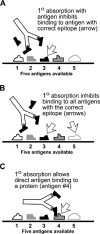Controls for immunocytochemistry: an update
- PMID: 20852036
- PMCID: PMC3201116
- DOI: 10.1369/jhc.2010.956920
Controls for immunocytochemistry: an update
Abstract
Immunocytochemistry is a highly productive method in biomedical research used to identify proteins and other macromolecules in tissues and cells. Control samples are required to show label localization is correct, but the understanding and use of immunocytochemistry controls have been inconsistent. A new classification of immunocytochemical controls is proposed that will help in understanding this most important component of the experiment. The three types of controls required for immunocytochemistry are primary antibody controls that show the specificity of the primary antibody binding to the antigen, secondary antibody controls that show the label is specific to the primary antibody, and label controls that show the labeling is the result of the label added and not the result of endogenous labeling. Publications containing immunocytochemical results must give details of how these controls were performed.
Conflict of interest statement
The author declared that some of the material and figures were from his book
Figures



Similar articles
-
The importance of titrating antibodies for immunocytochemical methods.Curr Protoc Neurosci. 2008 Oct;Chapter 2:Unit 2.12. doi: 10.1002/0471142301.ns0212s45. Curr Protoc Neurosci. 2008. PMID: 18972376
-
Specificity controls for immunocytochemical methods.J Histochem Cytochem. 2000 Feb;48(2):163-6. doi: 10.1177/002215540004800201. J Histochem Cytochem. 2000. PMID: 10639482
-
The specificity and patterns of staining in human cells and tissues of p16INK4a antibodies demonstrate variant antigen binding.PLoS One. 2013;8(1):e53313. doi: 10.1371/journal.pone.0053313. Epub 2013 Jan 8. PLoS One. 2013. PMID: 23308192 Free PMC article.
-
Freeze-fracture immunocytochemistry: fracture-label and label-fracture for the localization of membrane proteins.Curr Protoc Cell Biol. 2014 Dec 1;65:4.28.1-15. doi: 10.1002/0471143030.cb0428s65. Curr Protoc Cell Biol. 2014. PMID: 25447078 Review.
-
Peptide immunocytochemistry.Prog Histochem Cytochem. 1981;13(4):1-85. Prog Histochem Cytochem. 1981. PMID: 6166029 Review.
Cited by
-
Endometrial cancer and its cell lines.Mol Biol Rep. 2020 Feb;47(2):1399-1411. doi: 10.1007/s11033-019-05226-3. Epub 2019 Dec 17. Mol Biol Rep. 2020. PMID: 31848918 Review.
-
Development of a Novel FIJI-Based Method to Investigate Neuronal Circuitry in Neonatal Mice.Dev Neurobiol. 2018 Nov;78(11):1146-1167. doi: 10.1002/dneu.22636. Epub 2018 Sep 20. Dev Neurobiol. 2018. PMID: 30136762 Free PMC article.
-
An engineered three-dimensional stem cell niche in the inner ear by applying a nanofibrillar cellulose hydrogel with a sustained-release neurotrophic factor delivery system.Acta Biomater. 2020 May;108:111-127. doi: 10.1016/j.actbio.2020.03.007. Epub 2020 Mar 7. Acta Biomater. 2020. PMID: 32156626 Free PMC article.
-
Double Labeling Fluorescent Immunocytochemistry.Methods Mol Biol. 2022;2422:147-161. doi: 10.1007/978-1-0716-1948-3_10. Methods Mol Biol. 2022. PMID: 34859404
-
Optimization of immunostaining on flat-mounted human corneas.Mol Vis. 2015 Dec 30;21:1345-56. eCollection 2015. Mol Vis. 2015. PMID: 26788027 Free PMC article.
References
-
- Billinton N, Knight AW. 2001. Seeing the wood through the trees: a review of techniques for distinguishing green fluorescent protein from endogenous autofluorescence. Anal Biochem. 291:175-197 - PubMed
-
- Burry RW. 2000. Specificity controls for immunocytochemical methods. J Histochem Cytochem. 48:163-166 - PubMed
-
- Burry RW. 2010. Immunocytochemistry: a practical guide for biomedical research. New York: Springer
-
- Coons AH, Creech HJ, Jones RN, Berliner E. 1942. The demonstration of pneumococcal antigen in tissues by the use of fluorescent antibody. J Immunol. 45:159-170
Publication types
MeSH terms
Substances
LinkOut - more resources
Full Text Sources
Other Literature Sources

